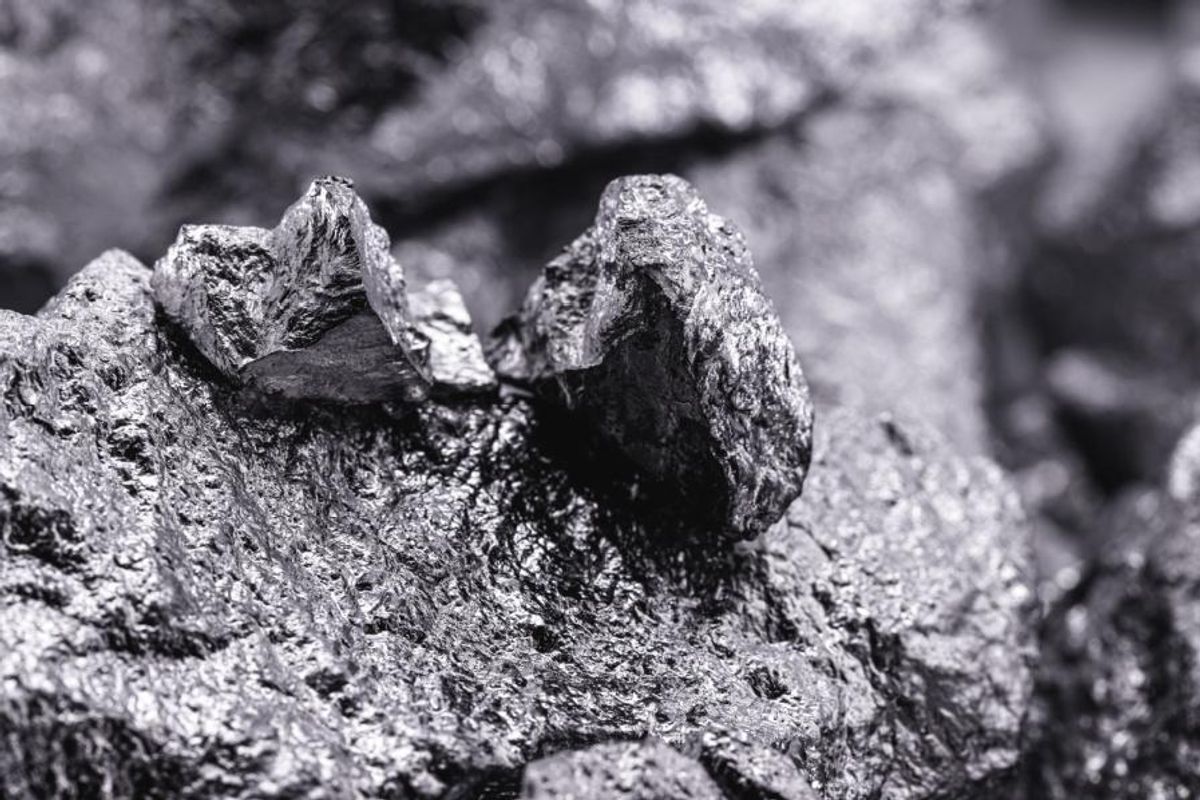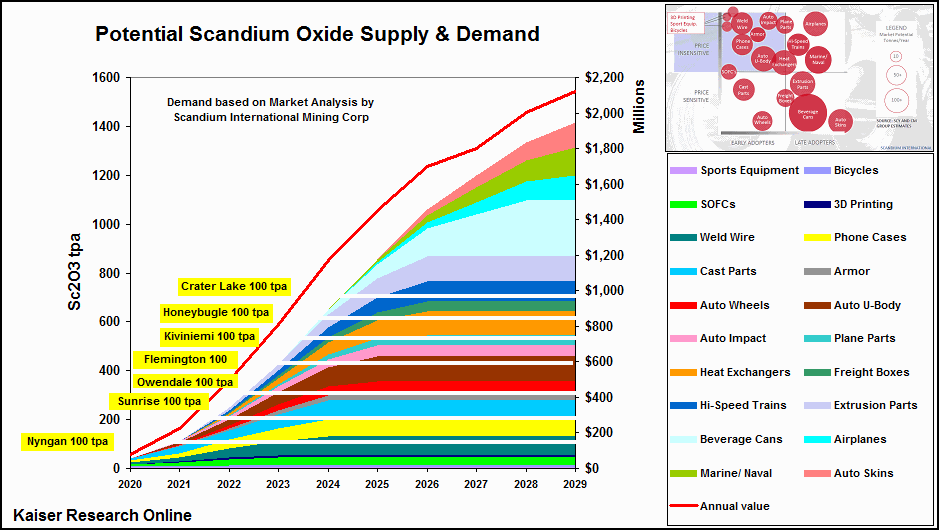How to Invest in Scandium Stocks
Commercially viable scandium deposits are rare, making widespread use of the metal tricky. However, there is indeed opportunity in the space.

Scandium is a critical metal that is as strong as titanium, as light as aluminum and as hard as ceramic.
While it is more abundant than lead, mercury and all the precious metals, there are no pure scandium-producing mines. The rare earth element is often a by-product, produced from refining metals such as uranium.
Pure scandium metal rarely concentrates at higher grades alongside other metals, making commercially usable scandium deposits very rare. What's more, even when scandium is found at elevated levels, processing it can be difficult, leading to very few stable sources of this critical metal. Unsurprisingly, that means scandium has seen very little commercial adoption.
However, as John Kaiser of Kaiser Research has pointed out several times in recent years, there has been promising research on how scandium could be used in the future, with research continuing to develop.
"Hundreds of applications (have been) filed, many of them related to alloys with aluminum," he said in an interview with the Investing News Network. "This obscure metal is going to go ballistic in the next few years." Kaiser made that statement in 2015, and scandium has yet to go ballistic. But he still has hope for the metal, and it may yet have its day in the sun.
Read on to learn more about scandium production, players in the space and the metal's potentially bright future.
Where is scandium produced?
The first known large-scale scandium production was associated with Russian military programs. Details are lost to history, but Russians reportedly alloyed the metal with aluminum to make lightweight MiG fighter parts. Mining at these historic Russian production sites has ceased, but stockpiles of scandium oxide and scandium master alloy remain in Russia. These stockpiles are rumored to be dwindling, but continue to be offered for sale on the market.
Today, most scandium is produced as a by-product during the processing of other ores, such as uranium or rare earths; it can also be recovered from previously processed tailings. As a result, scandium supply is tied to the supply and demand dynamics of the metals it is produced with, making the metal's already tough-to-follow dynamics even more difficult to understand.
According to the US Geological Survey, scandium-producing countries include China, where the critical metal is a by-product of iron ore, rare earths, titanium and zirconium; and the Philippines, where it is a by-product of nickel. Scandium is also produced as a by-product of uranium in Russia, Ukraine and Kazakhstan.
Scandium resources have been identified in minerals-rich regions across the world, most notably in Australia, where a number of junior mining companies are working to develop scandium deposits in New South Wales. These include Scandium International Mining (TSX:SCY), which controls the Nyngan project; and Sunrise Energy Metals (ASX:SRL,OTCQX:SREMF), which holds the Sunrise project. In August 2023, Rio Tinto (NYSE:RIO,ASX:RIO,LSE:RIO) acquired the Owendale project from Platina Resources (ASX:PGM,OTC Pink:PTNUF). Once operational, the project is expected to produce up to 40 metric tons per year of scandium oxide.
In the US, a decades-long hiatus in domestic scandium production may be nearing the end — NioCorp Developments' (TSX:NB,OTCQX:NIOBF) Elk Creek critical metals project holds probable reserves of an estimated 36 million metric tons containing 65.7 parts per million scandium. In the fall of 2023, the company successfully demonstrated pilot-scale production of 1 kilogram of aluminum-scandium ingot.
It's worth noting that the US Department of Defense (DOD) is supporting the development of domestic scandium production. In 2022, the government body approved US$30 million in grants under the Defense Manufacturing Community Support Program. About US$4.7 million of the funding is earmarked for the SAE Government Technologies-led Supply Chain of Recovered Elements Consortium (SCORE).
“The first focus of SCORE will be the extraction of scandium and integration into the aluminum alloys supply chain, supporting domestic manufacturing through castings, welding, and additive (3D printing) pathways,” states a Department of Defense press release.
How is scandium priced and traded?
The global scandium market is small compared to most other metals, but it is growing. This is exemplified by global supply and consumption, which the US Geological Surveys estimates at 30 to 40 metric tons annually for 2023 compared to 15 to 25 metric tons annually in 2021.
The US Department of Commerce and the International Trade Commission do not have specific trading data for the metal. Further, there is no formal buy/sell market — scandium is not traded on an exchange and there are no terminal or futures markets.
Instead, the metal is traded between private parties, mostly at undisclosed prices and in undisclosed amounts. For that reason, understanding the precise volume of production and cost of scandium is difficult, and independent estimations are more relevant.
Production estimates are based on levels of trader activity and interest, as well as the knowledge that some traders deal in the critical metal from very small operations.
The estimates also include consumers believed to be sourcing their own scandium through small, controlled recovery operations, but don't consider amounts of the metal contained in the master alloy currently being sold from Russian stockpiles.
What is the outlook for scandium?
IMARC analysts expect the global scandium market to grow at a compound annual growth rate of 6.3 percent between 2024 and 2032. "There is a considerable rise in the demand for solid oxide fuel cells (SOFCs) for producing electricity. This represents one of the key factors strengthening the growth of the market," the firm notes.
Despite the lack of known, stable supply, scientists and engineers have been working hard to develop new products incorporating the metal. Scandium's potential in high-tech applications is well documented. Highlights of the metal's properties include:
- It can be used in the creation of stronger, corrosion-resistant, heat-tolerant and weldable aluminum alloys for lightweight aircraft and automobiles.
- Its outstanding electrical properties and heat resistance are valuable for solid oxide fuel cells.
- It has unique optical properties for high-intensity lamps.
A recent Kaiser Research report on scandium details the wide variety of end uses for scandium now and into the future, as well as where potential supply to meet that demand may originate.

Potential scandium oxide supply and demand.
Graphic via Kaiser Research.
As Kaiser has said, "There's an enormous latent demand for scandium if it ever became available on a primary, scalable basis."
In other words, the only barrier to accessing demand from a new family of high-performance aluminum materials and energy/lighting products is the lack of commercially viable larger-scale scandium production. Interestingly, Kaiser's work highlights two important scandium market events that may "have the potential to launch scandium demand growth over the next decade towards a 1,000 (metric ton per annum) market worth US$2 billion."
For one, Rio Tinto announced in 2020 that it has developed a route to recovery for scandium at its Sorel-Tracy facility in Québec, where it produces titanium slag from the Lac Tio iron-titanium deposit.
In mid-2021, Rio Tinto began commercial-scale operations at its new scandium oxide production facility. By mid-2022, the company had announced the production of its first batch of high-purity scandium oxide at Sorel-Tracy. "The Rio Tinto development is a game changer for the scandium sector," said Kaiser, who believes the increase in scandium production could help boost the sector.
Commenting on Rio Tinto's recent acquisition of the Owendale project from Platina, Kaiser said, "The surprise decision by Rio Tinto to purchase Owendale for USD $8 million up front can be interpreted as meaning that Rio Tinto does see scandium offtake demand growing but it will take quite a few years."
Secondly, Scandium International Mining filed an application in late 2019 for a patent protecting a method for recovering scandium and other metals from the waste streams of copper oxide leaching operations. In mid-2020, the company announced that copper raffinate tests showed its patent-pending process could recover enough scandium to match the supply being added to the market by Rio Tinto.
As of October 2023, Scandium International Mining had broken ground on development work at the Nyngan project, which has scandium as a primary metal. "Given our ability to produce 38 tons annually under our mining license, we believe the Nyngan deposit is the most advanced Scandium project and will be one of the first projects to be developed when the market demand for Scandium becomes more mature," states a press release. A final investment decision is dependent on the company securing offtake agreements and strategic partnerships, which management says remain under discussion.
This is an updated version of an article originally published by the Investing News Network in 2014.
Don't forget to follow us @INN_Resource for real-time news updates!
Securities Disclosure: I, Melissa Pistilli, hold no direct investment interest in any company mentioned in this article.
Editorial Disclosure: The Investing News Network does not guarantee the accuracy or thoroughness of the information reported in the interviews it conducts. The opinions expressed in these interviews do not reflect the opinions of the Investing News Network and do not constitute investment advice. All readers are encouraged to perform their own due diligence.
